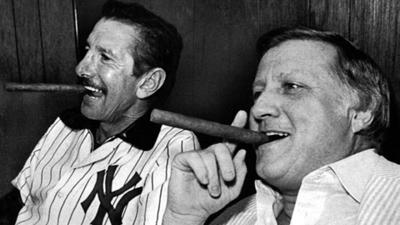The Red Sox’ “Truck Day” was Friday, as the tractor-trailer loaded up with spring-training equipment left Fenway Park bound for Fort Myers, Florida.
It was a day that used to be a huge day for Red Sox fans, but only the most die-hard of the die-hard would have braved Friday’s frigid temperatures to send off the Sunshine State-bound truck, given the state of the team as it heads into the 2023 campaign.
Yankee fans, Rays fans, Blue Jays fans, and even, believe it or not, Orioles fans, likely have much more optimistic views of their team as spring training looms, because all of those teams have realistic hopes of contention in baseball’s most competitive division.
The Red Sox, realistically, should not. ESPN on Friday listed Boston’s minor-league stockpile as 14th-best in MLB (with the Yankees, Rays, and Orioles all in the top 10), the team is 14th-highest in terms of payroll spending for 2023, and the team finished in last place last season. It marked the fifth time in the past 11 seasons that it had done so after not finishing in the AL East basement once between 1994 and 2012.
Indeed, these are dark times for Red Sox fans, even though they have the NHL-best Bruins and NBA-best Celtics to distract them in these coming months.
Meanwhile, the rival Yankees must be feeling particularly pleased entering this season, after re-signing their most valuable offensive asset (Aaron Judge) to a longtime extension (while the Red Sox let go just about every one of their unrestricted free agents), and also because the Pinstripers are coming off a season in which they reached the ALCS after comfortably finishing first in the AL East.
But there was also a time that is considered the “dark period” for Yankees fans of a certain generation when the team was not a perennial playoff contender and Fall Classic aspirant. There was actually a time before Joe Torre and Derek Jeter and Mariano Rivera when the Yankees really did, well, suck. They were ordinary or worse and annually were buried in the AL East standings, and even though the same blusterous man oversaw the operation — George Steinbrenner — and they had baseball’s highest payroll, it just didn’t matter. The Yankees, between the AL pennant-winning year of 1981 and the title year of 1996, actually did not win one pennant nor one divisional crown during that entire 15-year period, and instead were chronic underachievers and oftentimes the butt of jokes throughout the land.
For Red Sox fans, those are known as the golden years of the two teams’ ancient rivalry. The Sox weren’t world-beaters during that stretch either, but they did capture the pennant in 1986 and divisional honors in 1988 and 1990, all while enjoying the schadenfreude of watching their hated rivals languish.
That Yankees franchise won back-to-back world titles in 1977 and 1978 and later collected additional hardware in 1996, ’98, ’99, and 2000. But not only did the Pinstripers have a title drought throughout the ’80s and early ’90s, they were the crown princes of foolishness that made them the laughingstocks of the majors way back when.
Given some of the lunk-headed moves that the Yankees made then, it is difficult to believe that George Costanza was not part of the organization, given the franchise’s front-office ineptitude. Back then, no organization was more free-wheeling with its checkbook in offering big-money contracts to available players, and while the Yanks did harvest some home-grown talent, including the likes of Ron Guidry, Don Mattingly, and Mike Pagliarulo, the majority of the top-flight players that littered the roster during those years were signed free agents. Back then, only the Bombers were able to afford the bidding wars for marquee players’ talents — superstars like Dave Winfield, Reggie Jackson, Catfish Hunter, Don Gullett, Goose Gossage, Tommy John, Rickey Henderson, Don Baylor, and so on.
Some of those players produced, but many did not, and though that era confirmed defensive Yankee fans’ theory — that just spending the most money does not guarantee a title — the underachievement of the big-money players was not the primary reason for the Yankees being the object of ridicule.
One has only to look at the managerial merry-go-round that began in earnest in 1978 — the Yanks’ last title before the onset of that 18-year championship drought. In that particular season, the Yankees employed three managers during the course of the year, with (remember this name) Billy Martin getting the axe in late July despite a 52-42 record and a defending world champion on the field. (Martin had called Jackson and Steinbrenner “liars” in the days leading up to his dismissal, which was dubbed a “resignation for health reasons.”) Interim manager Dick Howser lost but one game following Martin’s tenure before he too was shuttled, and recently fired White Sox manager Bob Lemon was brought in to right the ship. Yet in a strange turn of events which was only the harbinger of things to come, the Yankees on Old-Timers’ Day four days later announced that Martin would return to manage the team in 1980 — nearly two years later.
Most New Englanders know how the ’78 season ended for both the Sox and Yanks (paging Bucky Dent!), but Martin didn’t have to wait until the spring of ’80, because he was brought back when the Yankees fired Lemon — who had led the Pinstripers to that ’78 title — on June 18, 1979 despite a 34-30 record.
But we’re not even close to the end of this tale, folks. After New York endured the death of catcher Thurman Munson along with a fourth-place finish in ’79, Martin was again replaced by Howser in 1980 after a pugilistic hotel confrontation with a marshmallow salesman, and Howser guided the team to a 103-59 record and another AL East title.
But the Yanks were swept by soon-to-be-champion Kansas City in the ALCS, and Howser was sent to a premature “retirement” by Steinbrenner. His replacement? Nope, not who you think — at least not yet — but instead, it was former Yanks infielder Gene Michael. Michael led the squad to an impressive 34-22 record out of the gate in 1981, but when the players’ strike split the season into two halves, New York’s second-half record under Michael — 14-12 en route to a 25-26 mark — wasn’t quite up to snuff for you-know-who, so the former shortstop was dismissed. Back in the saddle was Lemon, and though the Hall-of-Famer led the squad back to the World Series, the Yanks’ six-game loss to the Dodgers made his days numbered. Little did the team know at the time that it wouldn’t be returning to the Fall Classic for another 15 seasons, but the off-field hijinks continued, much to the delight of Yankee-haters everywhere.
When Lemon’s squad got off to a 6-8 start in ’82, off went the skipper into the sunset and who should come riding in but — nope, wait for it! — Gene Michael again. Alas, the Yanks finished in fifth place, just a game out of the cellar, and Stick was replaced in favor of Clyde King midway through the campaign when the team was 44-42 (and NY ultimately closed out the ’82 season at 79-83).
Are you sure you’re getting all this? All of these shenanigans happened in the five years after New York’s ’78 title, but the fun’s just beginning.
Not surprisingly, Martin was brought in for his third tour of duty in January of 1983, and that Yankees team finished 20 games over .500, but third place wasn’t good enough for the top brass, and to avoid a players’ mutiny and seemingly restore order to this incarnation of the Bronx Zoo, Yankee Hall-of-Famer Yogi Berra got to try his hand at the reins in 1984. Berra had led the crosstown Mets to a surprising NL pennant a decade earlier, and had even steered the Pinstripers to a pennant 20 years earlier, and seemed to be a breath of fresh air amidst the chaos of the revolving-door managerial situation in the Yankees clubhouse. Berra guided the team to a respectable 87-75 third-place finish, but once the team sputtered out of the gate the following season with a 6-10 record, the kibosh was put on the affable skipper’s managing career at age 60.
Now who should he be replaced by? Hmmm.
Would the fourth time be a charm for the author of Billyball? Not so much. The Pinstripers went 91-54 the rest of the way in ’85 following Berra’s exit, but the team fell two games short of the divisional lead behind the Blue Jays, and all the good things that came out of that promising season — an MVP season for Mattingly and a 20-win season for Guidry — could not prevent the inevitable from happening: the ouster of Alfred Manuel Martin.
But wait! Over? Nothing’s over until we say it is ... and despite two full seasons of managing by a former Yankee outfielder named Lou Piniella — including two 89-win seasons — the popular ex-Yank was also dismissed in the fall of ’87, only to be replaced with ... you guessed it — Martin again.
Sad, isn’t it? But this is the way it was for the Yankees during the decade of the ’80s, and when Martin was indeed brought back for a fifth (and, hallelujah, final) time in 1988, fans of the sport could only shake their heads at the mindless machinations of King George, the Yanks’ principal owner. And when Martin was fired for the final time in June (even though the team was 40-28), it was based more upon his pattern of his questionable behavior than his record on the field.
Until Torre was hired prior to the ’96 campaign, the Yankees went through five more managers, including Piniella one more time, Bucky Dent, Dallas Green, Stump Merrill, and (for a whopping four full seasons up until 1995) Buck Showalter, with little to show for it until the right guy came aboard in the fall of ’95.
At the time, Torre’s hiring wasn’t celebrated (he had winning records in just five of his 15 prior managerial seasons), but his delicate touch obviously worked wonders for the then–beleaguered franchise, and seven pennants and four world championships later, the New York Nine finally had their savior.
Now the team is again one of the hallmark organizations in baseball, even though a Steinbrenner (Hal) is still running the Yankees, but for those who love to hate the Striped Ones, it wasn’t all that long ago that the world was laughing at the Yankees, and Sox fans can take a little bit of solace heading into 2023 in remembering those days of Bronx-Bomber infamy.
Unfortunately, it’s the Red Sox who are the laughingstocks now.












